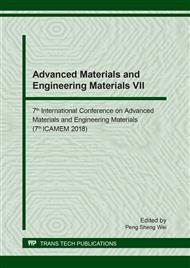[1]
K.C. Yung, H. Liem, H.S Choy, Z.X. Cai, Thermal investigation of a high brightness LED array package assembly for various placement algorithm, Applied Thermal Engineering 63 (2014) 105-118.
DOI: 10.1016/j.applthermaleng.2013.11.009
Google Scholar
[2]
E. Ozuturk, Voltage-current characteristic of LED according to some optical and thermal parameters at pulsed high currents, Optik-International Journal for Light and Electron Optics 126 (2015) 3215-3217.
DOI: 10.1016/j.ijleo.2015.07.147
Google Scholar
[3]
R. Feng, G. Jie, X. Hao, Determining the junction temperature of GaN-based blue LED with the double spectral parameter, Journal Optoelectronics·Laser 26 (2015) 2083-2088.
Google Scholar
[4]
Y. Xi, E.F. Schubert, Junction–temperature measurement in GaN ultraviolet light-emitting diodes using diode forward voltage method, International Journal of High Speed Electronics & Systems14 (2004) 708-713.
DOI: 10.1142/s0129156404002715
Google Scholar
[5]
Y. Xi, J.Q. Xi, Th. Gessmann, J. M. Shah, J. K. Kim, E. F. Schubert, A. J. Fischer, M. H. Crawford, K.H.A. Bogart, A.A. Allerman, Junction and carrier temperature measurements in deep-ultraviolet light-emitting diodes using three different methods, Appl. Phys. Lett. 86 (2005).
DOI: 10.1063/1.1849838
Google Scholar
[6]
H. Eugene, N. Nadarajah, A method for projecting useful life of LED lighting systems. Proc. Soc. Photo-Opt. Inst. Eng. 5187 (2004) 93-99.
Google Scholar
[7]
J. Hu, L. Yang, M.W. Shin, Mechanism and thermal effect of delamination in light-emitting diode packages, Microelectronics Journal 38 (2007) 148-154.
DOI: 10.1016/j.mejo.2006.08.001
Google Scholar
[8]
J. Han, J. Li, J. Deng, High bright AlGaInP red light LED, Journal Optoelectronics·Laser 19 (2008) 171-173.
Google Scholar
[9]
S. Li, W. Xia , D. Ma, Analysis on PIN type LED reverse breakdown characteristics. Journal Optoelectronics·Laser 17 (2006) 506-508.
Google Scholar
[10]
Y.J. Lee, C.J. Lee,.C.H. Chen, Determination of Junction Temperature in InGaN and AlGaInP Light-Emitting Diodes, IEEE Journal of Quantum Electronics 46 (2010) 1450-1455.
DOI: 10.1109/jqe.2010.2050866
Google Scholar
[11]
Y. Xi, Th. Gessmann, J.Q. Xi, J.K. Kim, J.M. Shah, E.F. Schubert, A.J. Fischer, M.H. Crawford, K.H. A.Bogart, A.A. Allerman, Junction temperature in ultraviolet light-emitting diodes, Japanese Journal of Applied Physics 44 (2005)7260-7266.
DOI: 10.1143/jjap.44.7260
Google Scholar
[12]
B.C. Chen, K.H. Chen, J.W. Yu, C.Y. Ho, M.Y. Wen, Analysis of junction temperatures for groups III–V semiconductor materials of light-emitting diodes, Optical & Quantum Electronics 49 (2017) 183-193.
DOI: 10.1007/s11082-017-1015-6
Google Scholar
[13]
S. Adachi, Lattice thermal conductivity of group-IV and III–V semiconductor alloys, Journal of Applied Physics 102 (2007) 063502.
DOI: 10.1063/1.2779259
Google Scholar
[14]
A.J. Fischer, A.A. Allerman, M.H. Crawford, K.H.A. Bogart, S.R. Lee, R.J. Kaplar, W.W. Chow, S.R. Kurtz, K.W. Fullmer, J.J. Figiel, Room-temperature direct current operation of 290 nm light-emitting diodes with milliwatt power levels, Applied Physics Letters 84 (2004).
DOI: 10.1063/1.1728307
Google Scholar
[15]
H.K. Lee, D.H. Lee Y.M. Song, , Y.T. Lee, J.S. Yu, Thermal measurements and analysis of AlGaInP/GaInP MQW red LEDs with different chip sizes and substrate thicknesses, Solid State Electronics 56 (2011) 79-84.
DOI: 10.1016/j.sse.2010.10.007
Google Scholar


